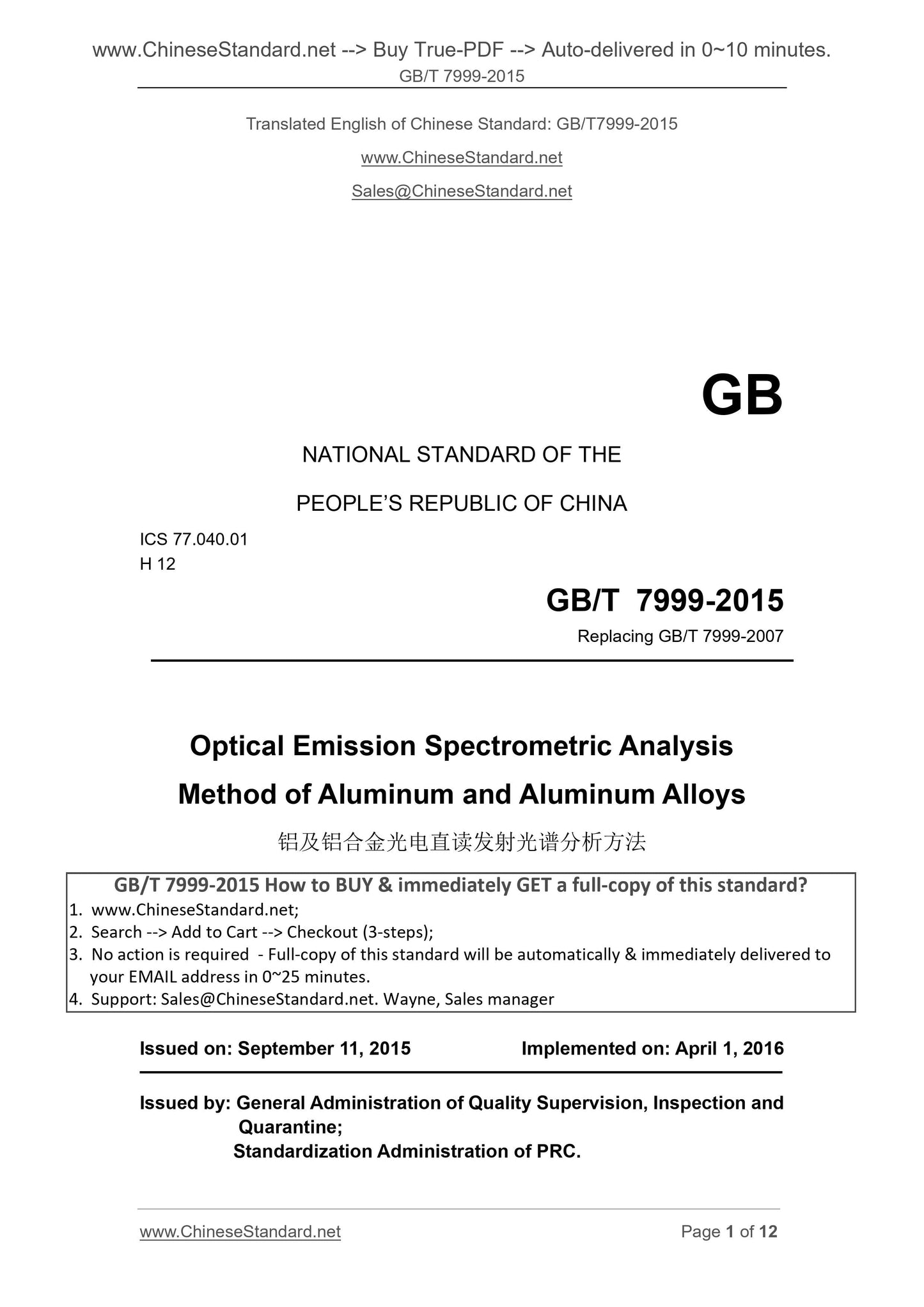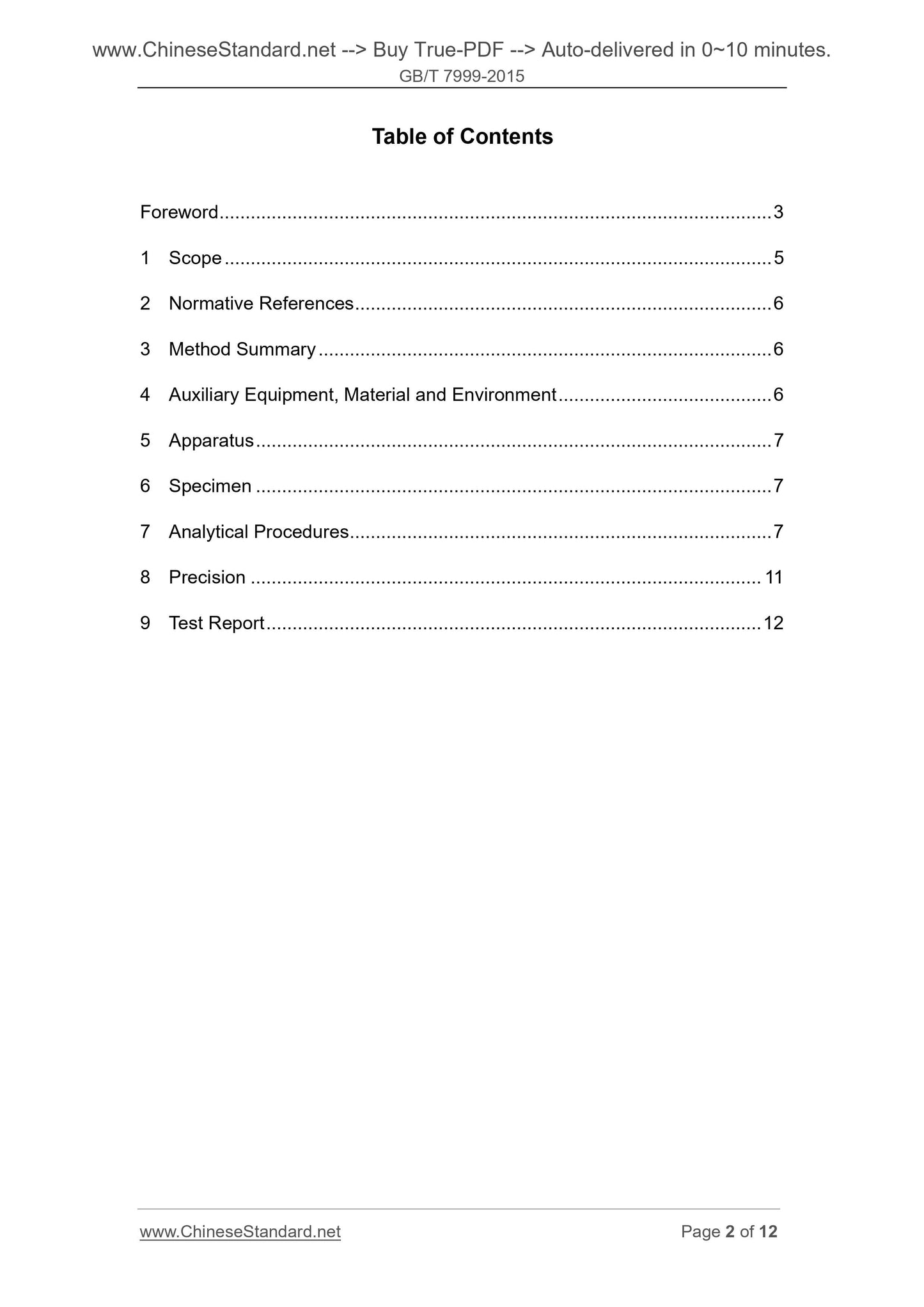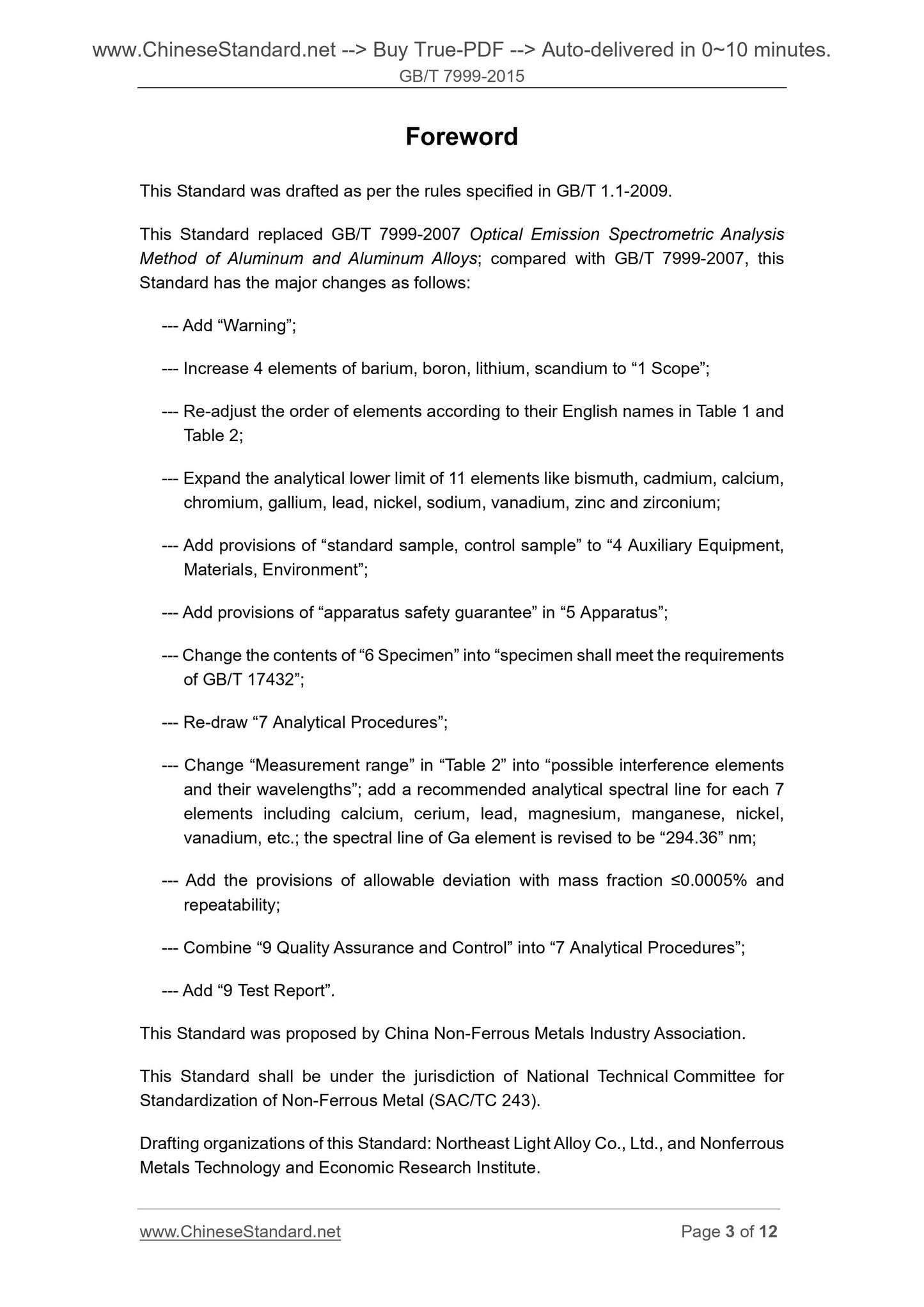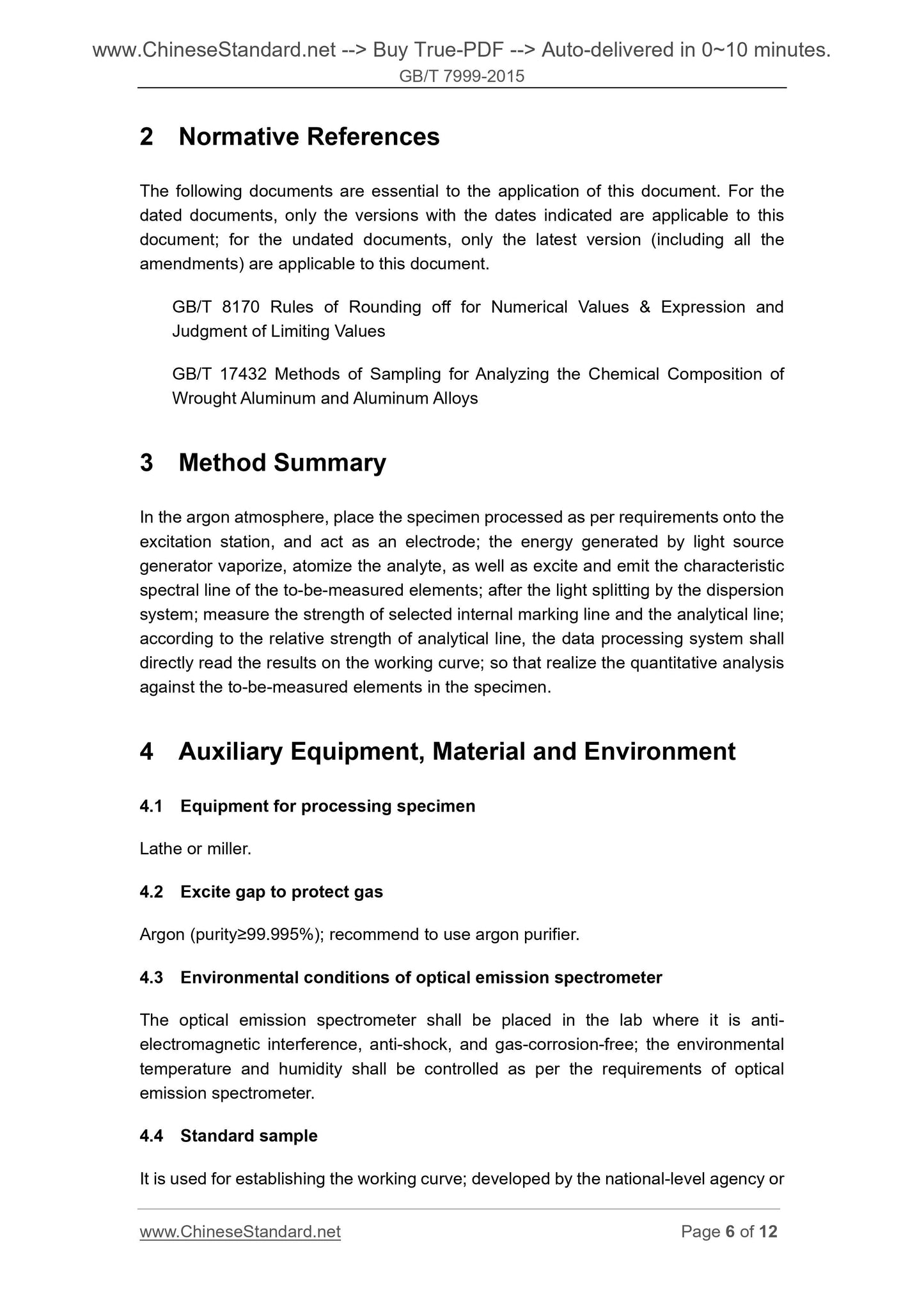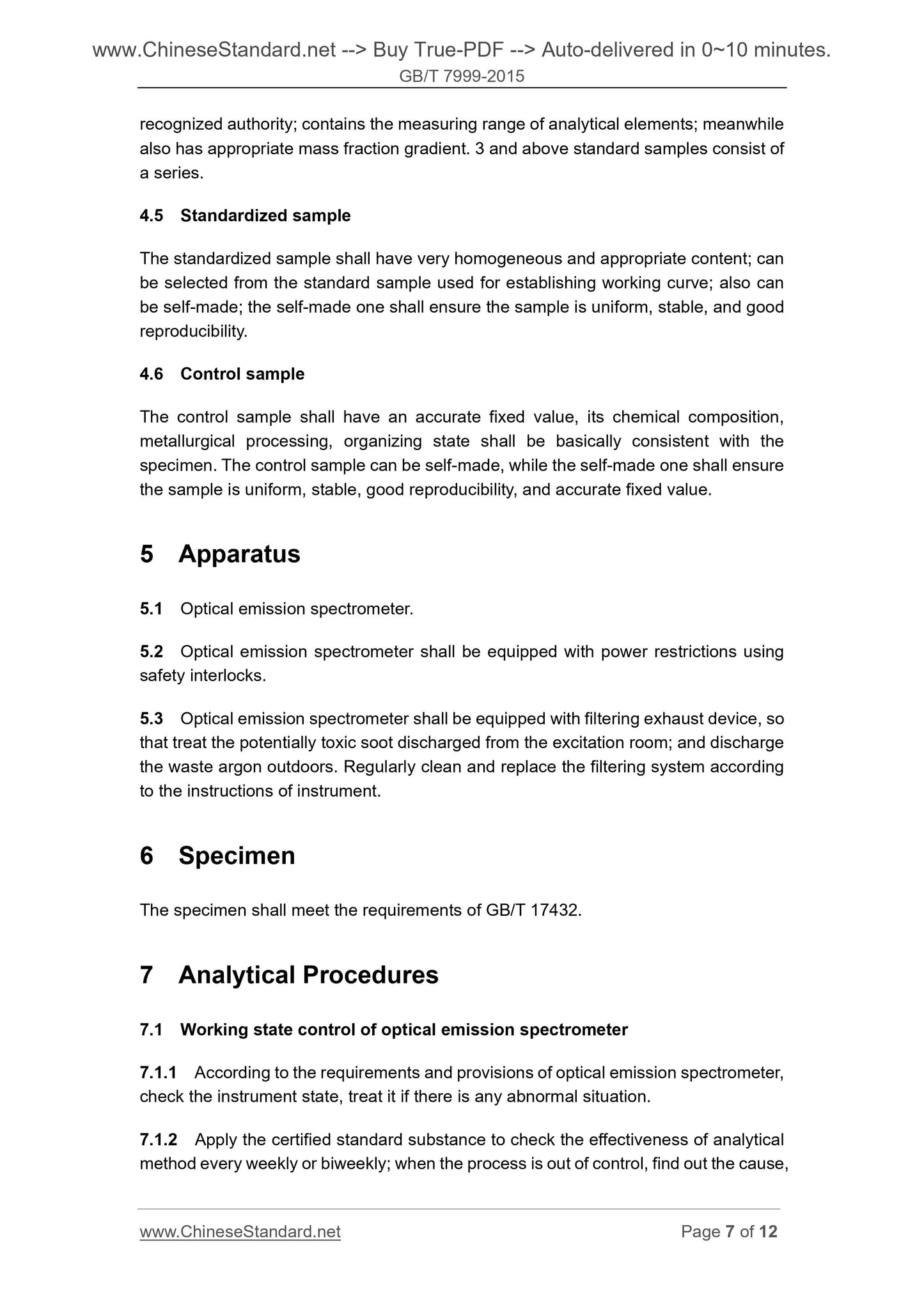1
/
of
5
PayPal, credit cards. Download editable-PDF and invoice in 1 second!
GB/T 7999-2015 English PDF (GBT7999-2015)
GB/T 7999-2015 English PDF (GBT7999-2015)
Regular price
$85.00 USD
Regular price
Sale price
$85.00 USD
Unit price
/
per
Shipping calculated at checkout.
Couldn't load pickup availability
Delivery: 3 seconds. Download true-PDF + Invoice.
Get QUOTATION in 1-minute: Click GB/T 7999-2015
Historical versions: GB/T 7999-2015
Preview True-PDF (Reload/Scroll if blank)
GB/T 7999-2015: Optical emission spectrometric analysis method of aluminum and aluminum alloys
GB/T 7999-2015
GB
NATIONAL STANDARD OF THE
PEOPLE’S REPUBLIC OF CHINA
ICS 77.040.01
H 12
Replacing GB/T 7999-2007
Optical Emission Spectrometric Analysis
Method of Aluminum and Aluminum Alloys
ISSUED ON. SEPTEMBER 11, 2015
IMPLEMENTED ON. APRIL 1, 2016
Issued by. General Administration of Quality Supervision, Inspection and
Quarantine;
Standardization Administration of PRC.
Table of Contents
Foreword ... 3
1 Scope ... 5
2 Normative References ... 6
3 Method Summary ... 6
4 Auxiliary Equipment, Material and Environment ... 6
5 Apparatus ... 7
6 Specimen ... 7
7 Analytical Procedures ... 7
8 Precision ... 11
9 Test Report ... 12
Foreword
This Standard was drafted as per the rules specified in GB/T 1.1-2009.
This Standard replaced GB/T 7999-2007 Optical Emission Spectrometric Analysis
Method of Aluminum and Aluminum Alloys; compared with GB/T 7999-2007, this
Standard has the major changes as follows.
--- Add “Warning”;
--- Increase 4 elements of barium, boron, lithium, scandium to “1 Scope”;
--- Re-adjust the order of elements according to their English names in Table 1 and
Table 2;
--- Expand the analytical lower limit of 11 elements like bismuth, cadmium, calcium,
chromium, gallium, lead, nickel, sodium, vanadium, zinc and zirconium;
--- Add provisions of “standard sample, control sample” to “4 Auxiliary Equipment,
Materials, Environment”;
--- Add provisions of “apparatus safety guarantee” in “5 Apparatus”;
--- Change the contents of “6 Specimen” into “specimen shall meet the requirements
of GB/T 17432”;
--- Re-draw “7 Analytical Procedures”;
--- Change “Measurement range” in “Table 2” into “possible interference elements
and their wavelengths”; add a recommended analytical spectral line for each 7
elements including calcium, cerium, lead, magnesium, manganese, nickel,
vanadium, etc.; the spectral line of Ga element is revised to be “294.36” nm;
--- Add the provisions of allowable deviation with mass fraction ≤0.0005% and
repeatability;
--- Combine “9 Quality Assurance and Control” into “7 Analytical Procedures”;
--- Add “9 Test Report”.
This Standard was proposed by China Non-Ferrous Metals Industry Association.
This Standard shall be under the jurisdiction of National Technical Committee for
Standardization of Non-Ferrous Metal (SAC/TC 243).
Drafting organizations of this Standard. Northeast Light Alloy Co., Ltd., and Nonferrous
Metals Technology and Economic Research Institute.
2 Normative References
The following documents are essential to the application of this document. For the
dated documents, only the versions with the dates indicated are applicable to this
document; for the undated documents, only the latest version (including all the
amendments) are applicable to this document.
GB/T 8170 Rules of Rounding off for Numerical Values and Expression and
Judgment of Limiting Values
GB/T 17432 Methods of Sampling for Analyzing the Chemical Composition of
Wrought Aluminum and Aluminum Alloys
3 Method Summary
In the argon atmosphere, place the specimen processed as per requirements onto the
excitation station, and act as an electrode; the energy generated by light source
generator vaporize, atomize the analyte, as well as excite and emit the characteristic
spectral line of the to-be-measured elements; after the light splitting by the dispersion
system; measure the strength of selected internal marking line and the analytical line;
according to the relative strength of analytical line, the data processing system shall
directly read the results on the working curve; so that realize the quantitative analysis
against the to-be-measured elements in the specimen.
4 Auxiliary Equipment, Material and Environment
4.1 Equipment for processing specimen
Lathe or miller.
4.2 Excite gap to protect gas
Argon (purity≥99.995%); recommend to use argon purifier.
4.3 Environmental conditions of optical emission spectrometer
The optical emission spectrometer shall be placed in the lab where it is anti-
electromagnetic interference, anti-shock, and gas-corrosion-free; the environmental
temperature and humidity shall be controlled as per the requirements of optical
emission spectrometer.
4.4 Standard sample
It is used for establishing the working curve; developed by the national-level agency or
recognized authority; contains the measuring range of analytical elements; meanwhile
also has appropriate mass fraction gradient. 3 and above standard samples consist of
a series.
4.5 Standardized sample
The standardized sample shall have very homogeneous and appropriate content; can
be selected from the standard sample used for establishing working curve; also can
be self-made; the self-made one shall ensure the sample is uniform, stable, and good
reproducibility.
4.6 Control sample
The control sample shall have an accurate fixed value, its chemical composition,
metallurgical processing, organizing state shall be basically consistent with the
specimen. The control sample can be self-made, while the self-made one shall ensure
the sample is uniform, stable, good reproducibility, and accurate fixed value.
5 Apparatus
5.1 Optical emission spectrometer.
5.2 Optical emission spectrometer shall be equipped with power restrictions using
safety interlocks.
5.3 Optical emission spectrometer shall be equipped with filtering exhaust device, so
that treat the potentially toxic soot discharged from the excitation room; and discharge
the waste argon outdoors. Regularly clean and replace the filtering system according
to the instructions of instrument.
6 Specimen
The specimen shall meet the requirements of GB/T 17432.
7 Analytical Procedures
7.1 Working state control of optical emission spectrometer
7.1.1 According to the requirements and provisions of optical emission spectrometer,
check the instrument state, treat it if there is any abnormal situation.
7.1.2 Apply the certified standard substance to check the effectiveness of analytical
method every weekly or biweekly; when the process is out of control, find out the cause,
Get QUOTATION in 1-minute: Click GB/T 7999-2015
Historical versions: GB/T 7999-2015
Preview True-PDF (Reload/Scroll if blank)
GB/T 7999-2015: Optical emission spectrometric analysis method of aluminum and aluminum alloys
GB/T 7999-2015
GB
NATIONAL STANDARD OF THE
PEOPLE’S REPUBLIC OF CHINA
ICS 77.040.01
H 12
Replacing GB/T 7999-2007
Optical Emission Spectrometric Analysis
Method of Aluminum and Aluminum Alloys
ISSUED ON. SEPTEMBER 11, 2015
IMPLEMENTED ON. APRIL 1, 2016
Issued by. General Administration of Quality Supervision, Inspection and
Quarantine;
Standardization Administration of PRC.
Table of Contents
Foreword ... 3
1 Scope ... 5
2 Normative References ... 6
3 Method Summary ... 6
4 Auxiliary Equipment, Material and Environment ... 6
5 Apparatus ... 7
6 Specimen ... 7
7 Analytical Procedures ... 7
8 Precision ... 11
9 Test Report ... 12
Foreword
This Standard was drafted as per the rules specified in GB/T 1.1-2009.
This Standard replaced GB/T 7999-2007 Optical Emission Spectrometric Analysis
Method of Aluminum and Aluminum Alloys; compared with GB/T 7999-2007, this
Standard has the major changes as follows.
--- Add “Warning”;
--- Increase 4 elements of barium, boron, lithium, scandium to “1 Scope”;
--- Re-adjust the order of elements according to their English names in Table 1 and
Table 2;
--- Expand the analytical lower limit of 11 elements like bismuth, cadmium, calcium,
chromium, gallium, lead, nickel, sodium, vanadium, zinc and zirconium;
--- Add provisions of “standard sample, control sample” to “4 Auxiliary Equipment,
Materials, Environment”;
--- Add provisions of “apparatus safety guarantee” in “5 Apparatus”;
--- Change the contents of “6 Specimen” into “specimen shall meet the requirements
of GB/T 17432”;
--- Re-draw “7 Analytical Procedures”;
--- Change “Measurement range” in “Table 2” into “possible interference elements
and their wavelengths”; add a recommended analytical spectral line for each 7
elements including calcium, cerium, lead, magnesium, manganese, nickel,
vanadium, etc.; the spectral line of Ga element is revised to be “294.36” nm;
--- Add the provisions of allowable deviation with mass fraction ≤0.0005% and
repeatability;
--- Combine “9 Quality Assurance and Control” into “7 Analytical Procedures”;
--- Add “9 Test Report”.
This Standard was proposed by China Non-Ferrous Metals Industry Association.
This Standard shall be under the jurisdiction of National Technical Committee for
Standardization of Non-Ferrous Metal (SAC/TC 243).
Drafting organizations of this Standard. Northeast Light Alloy Co., Ltd., and Nonferrous
Metals Technology and Economic Research Institute.
2 Normative References
The following documents are essential to the application of this document. For the
dated documents, only the versions with the dates indicated are applicable to this
document; for the undated documents, only the latest version (including all the
amendments) are applicable to this document.
GB/T 8170 Rules of Rounding off for Numerical Values and Expression and
Judgment of Limiting Values
GB/T 17432 Methods of Sampling for Analyzing the Chemical Composition of
Wrought Aluminum and Aluminum Alloys
3 Method Summary
In the argon atmosphere, place the specimen processed as per requirements onto the
excitation station, and act as an electrode; the energy generated by light source
generator vaporize, atomize the analyte, as well as excite and emit the characteristic
spectral line of the to-be-measured elements; after the light splitting by the dispersion
system; measure the strength of selected internal marking line and the analytical line;
according to the relative strength of analytical line, the data processing system shall
directly read the results on the working curve; so that realize the quantitative analysis
against the to-be-measured elements in the specimen.
4 Auxiliary Equipment, Material and Environment
4.1 Equipment for processing specimen
Lathe or miller.
4.2 Excite gap to protect gas
Argon (purity≥99.995%); recommend to use argon purifier.
4.3 Environmental conditions of optical emission spectrometer
The optical emission spectrometer shall be placed in the lab where it is anti-
electromagnetic interference, anti-shock, and gas-corrosion-free; the environmental
temperature and humidity shall be controlled as per the requirements of optical
emission spectrometer.
4.4 Standard sample
It is used for establishing the working curve; developed by the national-level agency or
recognized authority; contains the measuring range of analytical elements; meanwhile
also has appropriate mass fraction gradient. 3 and above standard samples consist of
a series.
4.5 Standardized sample
The standardized sample shall have very homogeneous and appropriate content; can
be selected from the standard sample used for establishing working curve; also can
be self-made; the self-made one shall ensure the sample is uniform, stable, and good
reproducibility.
4.6 Control sample
The control sample shall have an accurate fixed value, its chemical composition,
metallurgical processing, organizing state shall be basically consistent with the
specimen. The control sample can be self-made, while the self-made one shall ensure
the sample is uniform, stable, good reproducibility, and accurate fixed value.
5 Apparatus
5.1 Optical emission spectrometer.
5.2 Optical emission spectrometer shall be equipped with power restrictions using
safety interlocks.
5.3 Optical emission spectrometer shall be equipped with filtering exhaust device, so
that treat the potentially toxic soot discharged from the excitation room; and discharge
the waste argon outdoors. Regularly clean and replace the filtering system according
to the instructions of instrument.
6 Specimen
The specimen shall meet the requirements of GB/T 17432.
7 Analytical Procedures
7.1 Working state control of optical emission spectrometer
7.1.1 According to the requirements and provisions of optical emission spectrometer,
check the instrument state, treat it if there is any abnormal situation.
7.1.2 Apply the certified standard substance to check the effectiveness of analytical
method every weekly or biweekly; when the process is out of control, find out the cause,
Share
